In this post, I am resurrecting a regular series I began in 2009, talking about–Antique Wicker Furniture.
Wednesday seemed to be a good day of the week to focus on this topic and so began the Wednesday Wicker Wisdom series of posts.
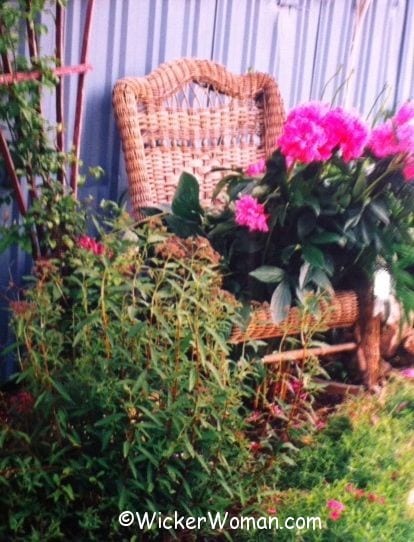
Here are a few pictures showing some pieces from the three primary antique wicker furniture eras of the Wicker Furniture Industry that began right here in the United States.
Of course, there were many more years that wicker furniture has been made over the centuries but these three are the most predominant and popular.
The three primary wicker furniture eras are:
- The Victorian Era (1860s-1890s)
- Turn of the Century (1900s-1920s)
- Machine Age (1920s-1940s)
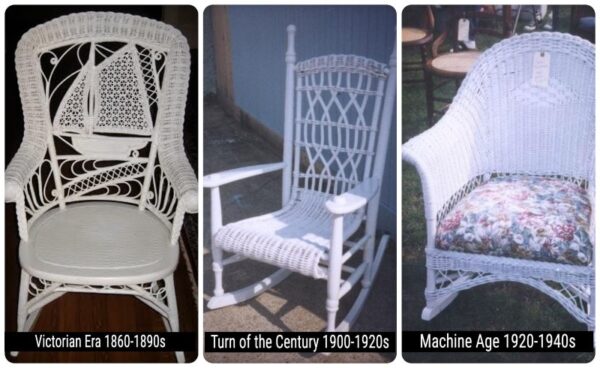
VICTORIAN WICKER–1860s-1890s
The Victorian Wicker Furniture era pieces were made up almost entirely of rattan reed poles or steam-bent hardwoods for the frames, round and flat rattan reed pith for the weavings and embellishments, and/or wrappings of cane or rattan reed pith.
The Victorian period wicker pieces came complete with elaborate ornamentation like curlicues and beads.
And sometimes, woven motifs on the backs appeared in the shape of sailboats, moons, stars, hearts, violins, initials, and animals.
Since this was not done on a great scale, any wicker piece with motifs are considered more valuable than those without any motifs.
Many times wicker pieces were also woven with complicated designs in the backs or handwoven caned back panels and under arms were woven using fancy spider-web or Star of David designs or patterns.
The Victorian Era Wicker Furniture pieces most often had close-woven, solid, sheet cane webbing in the seats.
Solid cane webbing was used rather than the open weave octagon pattern used in the hole-to-hole cane seats so as not to detract from the fancy embellished wicker backs and arms.
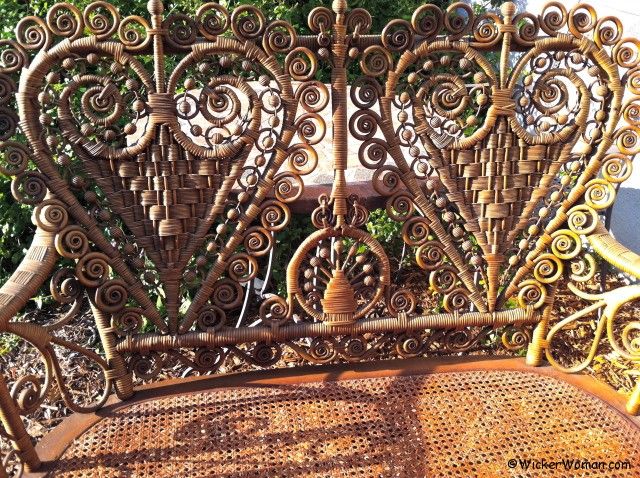
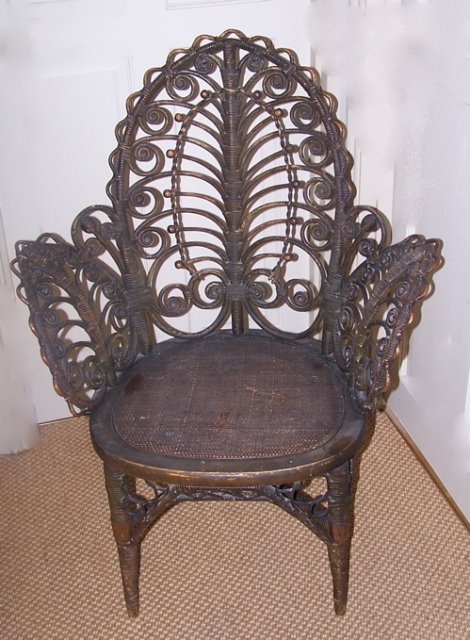
RELATED: Antique Wicker Furniture Motifs
TURN OF THE CENTURY WICKER–1900s-1920s
The Turn of the Century Wicker Furniture era included the short-lived Art Nouveau, an influence based on natural forms, characterized by flowing, wavelike lines.
These pieces were all handmade, done with natural materials and lasted until shortly after the turn of the 18th century.
It also included the invention of the man-made twisted paper fibre of 1904, which became known as “paper wicker or paper fibre wicker.”
Turn of the Century wicker furniture was also made up of the Mission-style wicker introduced by Gustav Stickley, which had straight lines and open latticework, plain styles and designs.
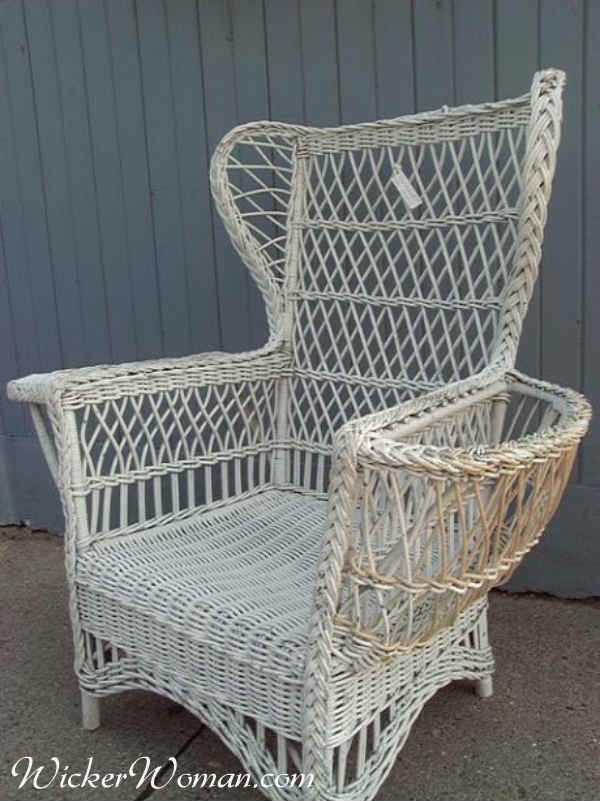
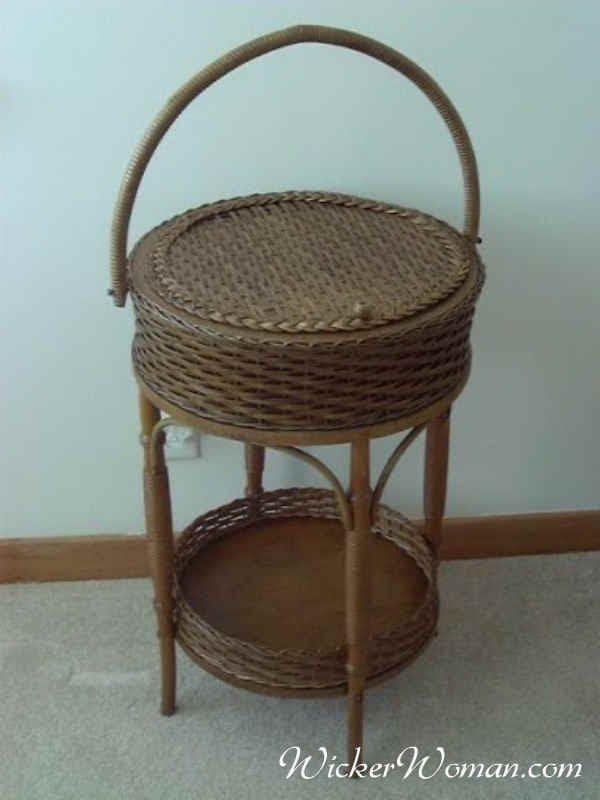
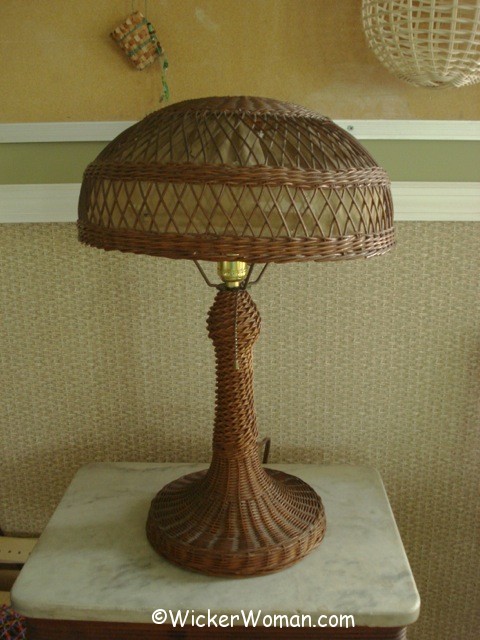
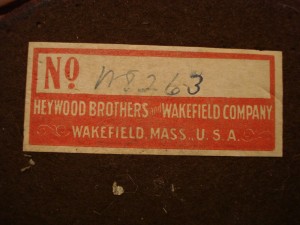
MACHINE AGE WICKER–1920-1940s
During the Machine Age Wicker Furniture Industry came the invention of the mechanized Lloyd Loom, which eliminated much of the manual workforce.
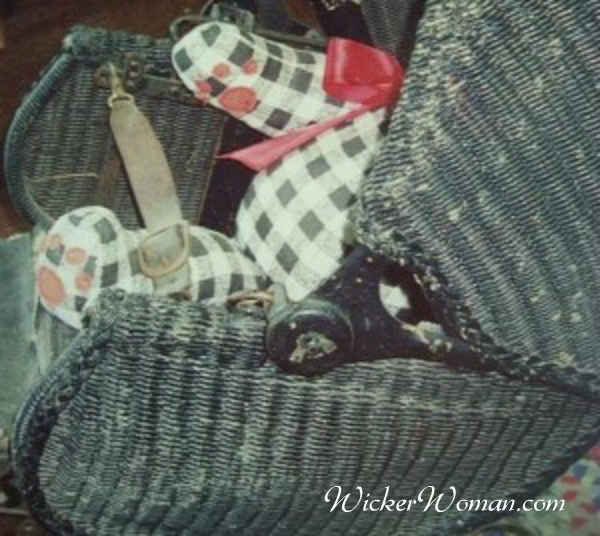
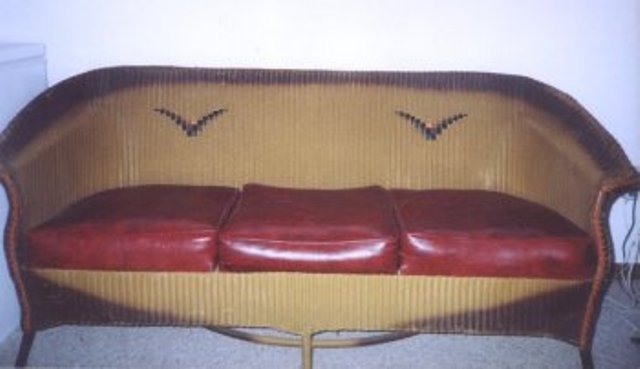
Paper rush or paper fibre wicker was now mass-produced and included a wire core center for spoke support on backs and under the arms and the weaver strands were still used without the wire core.
Upholstered backs and seat cushions were now the rage, eventually incorporating inner-spring seats.
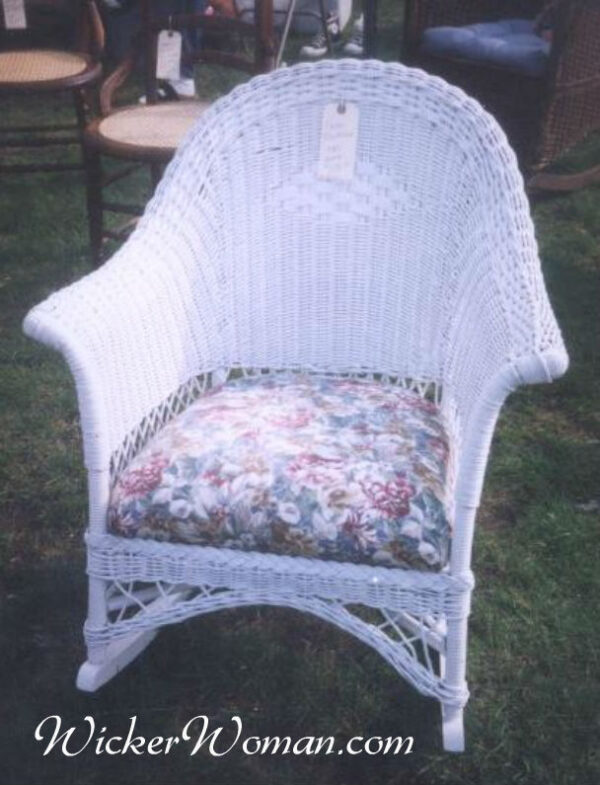
At the tail end of the Machine Age was the Art Deco style, utilizing paper fibre rush characterized by fancywork of multi-colored diamond patterns woven into backs of chairs and settees.
RELATED: Paper Fibre Rush Wicker
And stick wicker was also introduced at this time with its simple designs using round, skin-on rattan poles. Stick wicker sets were frequently made in sets with tables, chairs, couches and lamps to use either inside or on a covered porch.
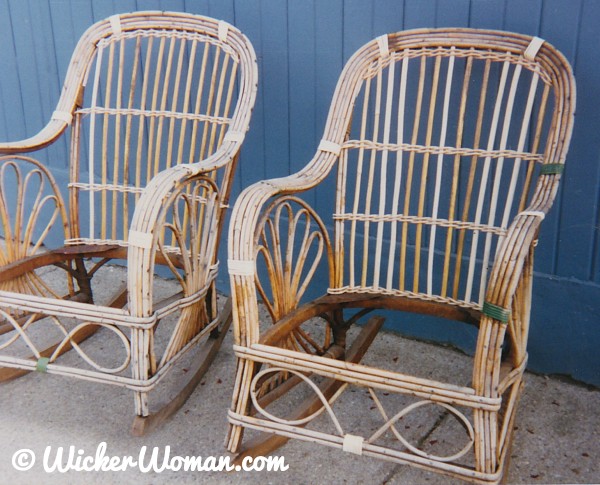
I hope you’ve enjoyed learning about the three primary wicker furniture industry eras of the Victorian, Turn of the Century and the Machine Age.
Check out the Wicker Furniture FAQ page if you have questions about your wicker furniture and to get more hints and tips.
If you’d like to read some of the older Wednesday Wicker Wisdom posts, you can click on the link or visit the Wicker Wisdom category in the right sidebar and you’ll come up with quite a few. Enjoy!
Please share this article with your friends, family, and social networks. Please let me know in the comments below about any wicker furniture you may have in your family. Do you have any antique wicker from these three primary wicker furniture eras?

What are your thoughts about this blog post?
Leave your comments below and share with your social networks!
~~Live Well, Laugh Often, Love Much ~~
Happy Weaving, until next time!



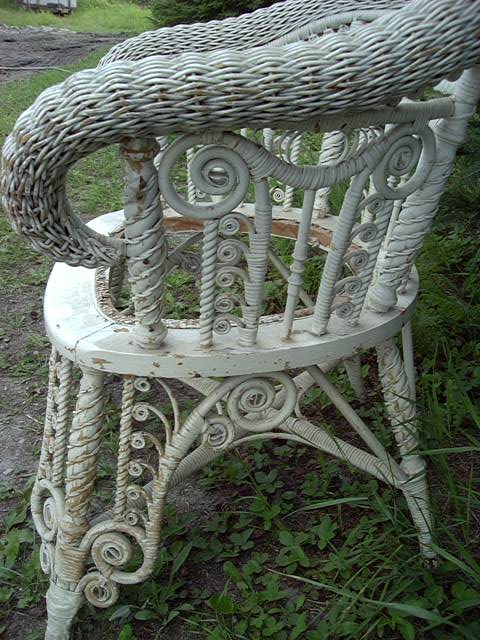
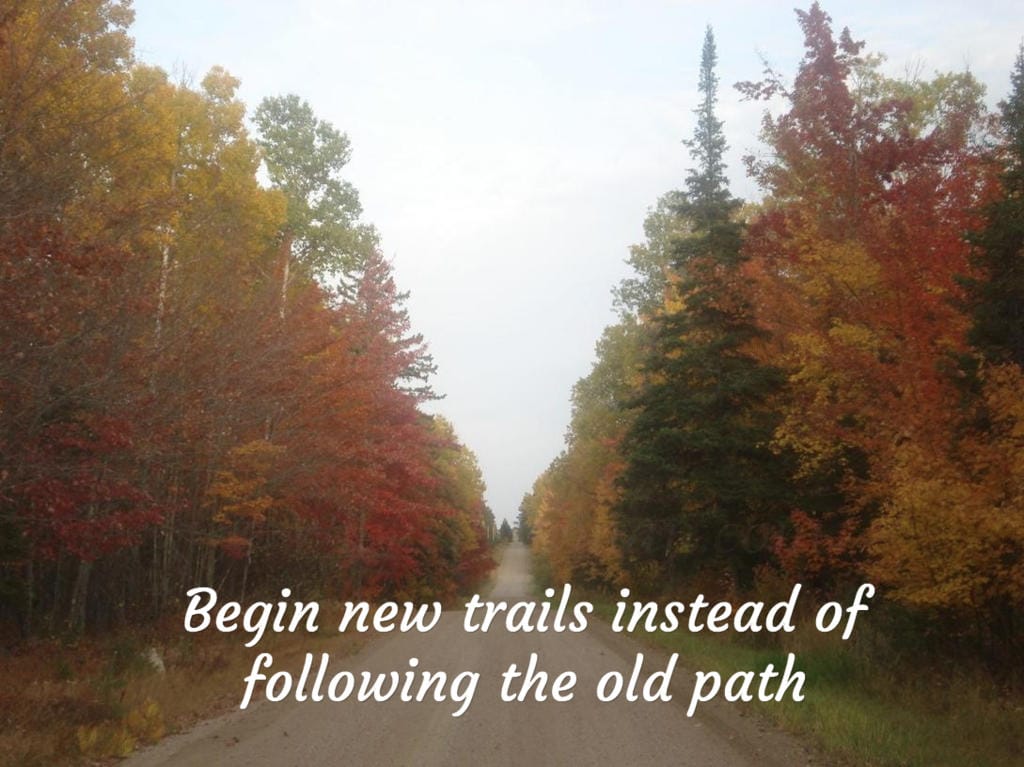
It’s very interesting. I’ve just begun to research
Some wicker designs. So I’m looking for more information on the designers who uses a more feminine look. No sharp edges, and rounded more. Where can I see pictures of wicker designs & designers. Thanks
Hi Jackie,
I wish I could give you some names and directions to pursue with the wicker designers, but there are not really any specifically designers for the antique wicker furniture, but rather manufacturing companies, instead.
All of the early wicker from the 1840s until the Victorian era wicker of the 1890s, had the feminine lines with the rounded corners and swooping backs, arms and aprons adorned with fancy embellishments. So, that’s where I’d suggest you start your research.
As the Arts & Crafts Mission era came about, the lines were straight and much more masculine. If you want to do more current research, maybe beginning with the Danish furniture makers might be a good place to start with more contemporary pieces.
Here is a selection of antique wicker furniture books, which all cover the beginning manufacturing companies as well as the more modern pieces. Antique Wicker Furniture Books
I have a wicker rocker and foot stool set. The rocker has a squared off back top, unlike the common rounded top. The arms are supported by diagonally, steam bent, medium sized sticks, on the front and rear corners. Also, it has cushions, the seat itself has springs below, that the cushioning is placed atop. I have failed at finding any makers marks. Would you guess 1920’s? Bring there is not springs in the cushion it’s self. Thank you for your insight!
I have 2 wicker rockers high back round with removable spring seats. That came from a hotel as far back as early 1900s. They are featured in a post card and pictures of historical information. They were perfect, then as they were left in the weather have started to degrade, I am desprate to restore these. Is there anywhere I can contact to do so, I simply do not know what I am doing, to try this on my own.
Please help!
Judy F.
Hello; I just rescued a wicker sofa from a garage which was about to get demolished. It’s brown with a series of three green diamonds running the width of the back. After having read your post here I’ve learned that it’s likely from the 1930s, and is made of twisted paper wicker. It’s in good shape but there are two or three places where the wicker has unraveled, and there are wear spots wear the color is gone. Where can I go to learn about touching up the color, and how do I fix the small unraveled areas. The couch looks great and is usable now, but I would like to make it even better. It still has the original upholstery on the spring frame seats. It was protected by the three generations of upholstery that had been built up on top of it.
Hello Carl,
It’s great that you saved the wicker couch from being destroyed, way to go! Sounds like you have an art deco, paper fibre wicker couch from the 1930s as you’ve discovered. To make repairs on these types of wicker pieces is not usually too difficult.
You will need to purchase the same type of materials and make sure to follow the exact same design and pattern as the old one before you removed it. And then paint the repair spots to match the rest of the piece. Be sure to take lots of pictures before you begin making the repairs so you will be able to replicate the pattern.
Purchase your supplies from any of the great businesses listed on my Cane & Basket Supplies Directory™ and you can purchase the definitive wicker repair book called, How to Buy and Restore Wicker Furniture by Thomas Duncan from my (affiliate) Amazon Store.
Thanks so much for this! My mom has a wicker chair she got in the 1980s from a woman who was cleaning out her attic and she recently gave it to me. It was a staple in my house growing up and she rocked all the grandkids in it. I have had the hardest time finding it, even dating it, and your blog helped me a ton! I will be checking out the rest of your site for more info as I work toward refinishing this chair! Thank you!
I have a heart back wicker/rattan stick and ball looking high back chair. Trying to identify the maker.
We bought a settee – couch with two wicker rockers from a gentlemen who said that it had been his grandmothers and he believed it was from at least the 1920’s as he has photos of her sitting on it during that time period. It has springs in the seat area and has the diamond pattern woven in it. The chairs are rockers. It has very little damage to the wicker and may need some springs repaired. We live in the Fayetteville Arkansas area and would like to know if you have any references for someone who could help us with some restoration. It is all white and very pretty.
Hi Susan,
How wonderful that you have the provenance regarding your wicker purchase! Usually, the inner springs in removable seat cushions were used in the wicker furniture made during the 1930s but it’s possible that yours might have been made during the late 1920s.
Since 2004, I’ve had a National Furniture Repair Directory™ set up on my site which lists repair experts from all over the country in the fields of Wicker, Caning, Refinishing and Upholstery. You can find the Furniture Repair Directory™ at the top of every page in the navigation area.
Be sure to check both the Wicker, Chair Caning, and Upholstery categories since there’s cross-over between disciplines. So happy to be of help for you here, Susan. Thanks for visiting my site and reading the blog!
I have morethan a truck load of basket weaving materials… everything from kits to bases to handles to reeds to things to decorate them and patterns galore… looking for someone to buy it all.. 8562379930. Thank you Robyn
Robyn, have you checked with the many basketweaving guilds to see if their members would like to buy your stock of weaving materials? Go to my Links page of Basket Guilds where you’ll find a list of guilds across the US and some in Canada too. You didn’t mention what state you live in, but most states have basketry guilds. Hope you find someone! https://www.wickerwoman.com/links/basket-guilds